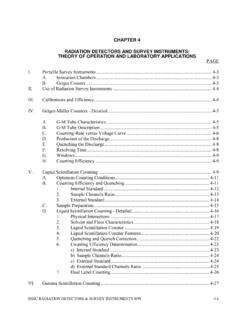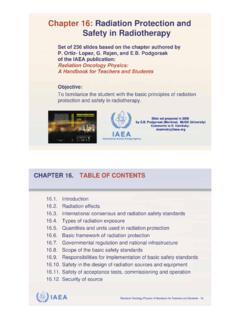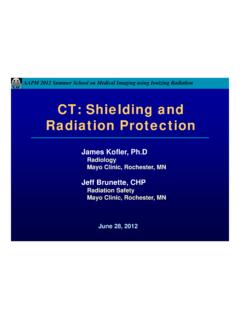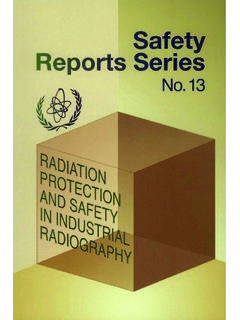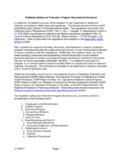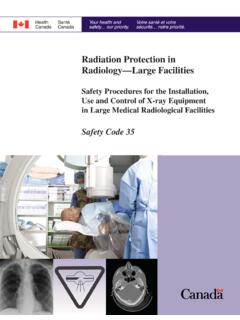Transcription of CHAPTER 3 RADIATION PROTECTION - University of Florida
1 RSSC RADIATION PROTECTION 07/11 3-1 CHAPTER 3 RADIATION PROTECTION PAGE I. External RADIATION PROTECTION .. 3-3 A. Time .. 3-3 B. Distance .. 3-3 1. The Inverse Square Law .. 3-3 2. Gamma Constants .. 3-4 3. Gamma Exposure Rate Formula .. 3-5 C. Shielding .. 3-6 1. Alpha and Beta RADIATION .. 3-6 2. X- and Gamma RADIATION .. 3-6 3. Half Value Layer .. 3-8 D. External Exposure Personnel Monitoring .. 3-9 1. Types of Personnel Dosimeters .. 3-9 2. Use of Personnel Dosimeters .. 3-11 3. Maximum Permissible Exposure Limits .. 3-14 E. Posting and Labeling of Radioactive Materials .. 3-15 1. Cautionary Signs .. 3-15 2. Department of Transportation Warning Labels .. 3-16 II. Internal RADIATION PROTECTION .. 3-17 A. Radioactive Materials in the Body .. 3-17 B. Guidelines .. 3-18 C. Limits .. 3-18 D. Internal Exposure Monitoring .. 3-19 III. General Precautions and Rules of 3-20 IV.
2 Specific Handling Precautions for Various Radionuclides .. 3-23 A. H-3 .. 3-24 B. C-14 .. 3-25 C. P-32 .. 3-26 D. P-33 .. 3-27 E. S-35 .. 3-28 F. Cr-151 .. 3-29 G. I-125 .. 3-30 H. Radioiodination and Safety .. 3-31 Appendix 1: Application of Bioassay for Tritium .. 3-35 Appendix 2: Applications of Bioassay for I-125 and I-131 .. 3-38 3-2 RSSC RADIATION PROTECTION 07/11 Appendix 3: Selected Constants and Data .. 3-42 Gamma RADIATION levels for selected radionuclides .. 3-43 Reference data for selected radioisotopes .. 3-44 Penetration ability of beta RADIATION .. 3-45 Mass attenuation coefficients .. 3-46 Density of elements and common materials .. 3-50 Half-value layer for gamma and x-ray radiations .. 3-52 RSSC RADIATION PROTECTION 07/11 3-3 RADIATION PROTECTION I. EXTERNAL RADIATION PROTECTION The three basic methods used to reduce the external RADIATION hazard are time, distance, and shielding.
3 Good RADIATION PROTECTION practices require optimization of these fundamental techniques. A. Time The amount of RADIATION an individual accumulates will depend on how long the individual stays in the RADIATION field, because: Dose (mrem) = Dose Rate (mrem/hr) x Time (hr) Therefore, to limit a person s dose, one can restrict the time spent in the area. How long a person can stay in an area without exceeding a prescribed limit is called the "stay time" and is calculated from the simple relationship: Stay Time = (mrem/hr) Rate Dose(mrem)Limit Example: How long can a RADIATION worker stay in a rem/hr RADIATION field if we wish to limit his dose to 100 mrem? Stay Time = mrem/hr 1500mrem 100 = hr = 4 minutes B. Distance The amount of RADIATION an individual receives will also depend on how close the person is to the source.
4 1. The Inverse Square Law - Point sources of x- and gamma RADIATION follow the inverse square law, which states that the intensity of the RADIATION (I) decreases in proportion to the inverse of the distance from the source (d) squared: 21dI This can be rewritten: 21dKI where K is a constant of unknown value. So, for an intensity I1 at distance d1, and another intensity I2 at distance d2: 2111dKI ; 2221dKI 3-4 RSSC RADIATION PROTECTION 07/11 Now solve for the relationship by eliminating K: 21II = 2221dKdK 21II = 2122dd OR 211dI = 222dI Therefore, by knowing the intensity at one distance, one can find the intensity at any other distance. Example: The exposure rate one foot from a source is 500 mR/hr. What would be the exposure rate three feet from the source? 1I = 500 mR/hr 1d = 1 foot 2d = 3 feet 2d = 22211ddI = 22)ft 3()ft 1)(mR/hr 500( = 9mR/hr 500 = mR/hr 2.
5 Gamma Constants Gamma RADIATION levels (in R/hr) for one curie of many radionuclides at a distance of one meter have been measured. These gamma constants can be used to determine 1) the expected exposure rate at a given distance (using the inverse square law) for a known quantity of a radionuclide, or 2) the activity of a radionuclide from a measured exposure rate. Gamma constants ( ) for selected radionuclides can be found on page 43. To determine the gamma RADIATION level in R/hr at one meter per curie, or equivalently, mR/hr at one meter per millicurie, you must divide the tabulated gamma constants ( ) by 10. Example No. 1: What is the RADIATION exposure rate one foot from a 100 mCi point source of Cs-137? RSSC RADIATION PROTECTION 07/11 3-5 = R-cm2/hr-mCi OR /10 = R/hr at 1 meter/Curie = mR/hr at 1 meter/mCi 211dI = 222dI 1I = ?
6 2I= mR/hr/mCi x 100 mCi = 33 mR/hr 2d= 1 meter 1d = 1 foot = m 1I = 21222ddI = 22)m ()m 1)(mR/hr 22( = 355 mR/hr Example No. 2: If the exposure rate from Cs-137 at one meter is 250 mR/hr, how many Curies are present? R/hr/ = .076 Curies 3. Gamma Exposure Rate Formula The exposure rate from a gamma point source can be approximated from the following expression: mR/hr = 26dCEf Where: C is the activity of the gamma emitter, in millicuries E is the gamma ray energy in MeV f is the fraction of disintegrations yielding the gamma of energy E d is the distance from the source in feet If more than one gamma ray is emitted by the radionuclide of interest, then the contribution from each one must be calculated separately and summed. This expression is accurate to about 20% for gamma emitters with energies ranging from MeV to 4 MeV.
7 3-6 RSSC RADIATION PROTECTION 07/11 Example: What would the exposure rate be one foot away from 100 mCi of I-131? From the reference data for I-131 on page 44: I-131 : 1 = MeV, /d 2 = MeV, /d R/hr at 1 foot = 6 ( ) [( x ) + ( x )] = R/hr at 1 foot = 210 mR/hr at 1 foot C. Shielding When reducing the time or increasing the distance may not be possible, one can choose shielding material to reduce the external RADIATION hazard. The proper material to use depends on the type of RADIATION and its energy. 1. Alpha and Beta RADIATION Alpha particles are easily shielded. A thin piece of paper or several cm of air is usually sufficient to stop them. Thus, alpha particles present no external RADIATION hazard. Beta particles are more penetrating than alpha particles. Beta shields are usually made of aluminum, brass, plastic, or other materials of low atomic number to reduce the production of bremsstrahlung RADIATION .
8 The range of beta RADIATION for various energies in air, plastic and various materials can be found on page 45. 2. X and Gamma RADIATION Monoenergetic x- or gamma rays collimated into a narrow beam are attenuated exponentially through a shield according to the following equation: I = Ioe - x where I is the intensity outside of a shield of thickness x Io is the unshielded intensity is the linear attenuation coefficient of the shielding material x is the thickness of shielding material. The linear attenuation coefficient is the sum of the probabilities of interaction per unit path length by each of the three scattering and absorption processes - photoelectric effect, RSSC RADIATION PROTECTION 07/11 3-7 Compton effect, and pair production. Note that has dimensions of inverse length (1/cm). The reciprocal of is defined as the mean free path, which is the average distance the photon travels in an absorber before an interaction takes place.
9 Because linear attenuation coefficients are proportional to the absorber density, which usually does not have a unique value but depends somewhat on the physical state of the material, it is customary to use the mass attenuation coefficient, which removes density dependence: Mass attenuation coefficient m = where = density (g/cm3) For a given photon energy, m does not change with the physical state of a given absorber. For example, it is the same for water whether present in liquid or vapor form. If the absorber thickness is in cm, then m will have units of 31g/cmcm = cm2/g. Values of the mass attenuation coefficient and densities for various shielding materials can be found on pages 46-49 and pages 50-51, respectively. Using the mass attenuation coefficient instead of the linear attenuation coefficient, the attenuation equation can be rewritten: I = xomeI NOTE: Lead is a common shielding material for x-rays and gamma RADIATION because it has a high density, is inexpensive, and is relatively easy to work with.
10 When working with a radionuclide that emits multiple types of RADIATION such as beta particles and gamma RADIATION , it is sometimes necessary to shield with several materials. The less penetrating beta RADIATION can first be shielded with a layer of plastic or Plexiglas, thereby slowing or stopping the beta particles while reducing the production of bremsstrahlung. The more penetrable gamma RADIATION would require an additional layer of shielding. Types of shielding and amount of shielding vary depending on photon energy. A good rule of thumb: shield the less penetrable RADIATION type first then proceed to shield the more penetrable type. This usually decreases both scattering and the total amount of shielding material required. Example: The intensity of an unshielded Cs-137 source is 1 R/hr. If the source is put into a lead shield two (2) inches thick, what would be the intensity on the outside of the shield?
